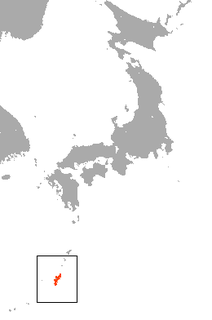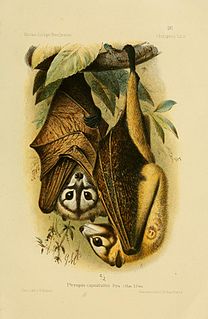
The Aldabra flying fox is a species of megabat in the genus Pteropus. It is endemic to the Aldabra Atoll in the Seychelles, like Chaerephon pusilla, though the latter may be the same species as the little free-tailed bat.

The Vanuatu flying fox or white flying fox is a species of flying fox in the family Pteropodidae. It is endemic to Vanuatu. It is most closely related to the Samoa flying fox.

Gilliard's flying fox is a species of flying fox in the family Pteropodidae. In Spanish, the common name is zorro volador de Gilliard. It is endemic to Papua New Guinea. It is known from only three specimens.

The gray flying fox is a species of flying fox in the family Pteropodidae. It is not to be confused with the grey flying fox. It is found in Indonesia, but not in the Philippines, despite occasional reference to such. Very little is known about this species. The gray flying fox has small size and neutral coloration with a brownish head and an orange abdomen. It probably roosts individually or in small groups. It was listed on appendix II of CITES, and is classified as "Data Deficient" by the IUCN. This species has been decimated by hunting for bushmeat in Indonesia. The hunters use fishing hooks, ropes, and other supplies to hunt the bats. The ropes and hooks are placed along their flight paths, tearing and ensnaring the bats' wings when are flying. In the course of a hunting season, entire colonies can be killed.

The small flying fox, island flying fox or variable flying fox is a species of flying fox in the family Pteropodidae. It is found in Australia, Cambodia, Indonesia, Malaysia, the Maldives, Myanmar, Papua New Guinea, the Philippines, the Solomon Islands, Thailand, and Vietnam.

The Okinawa flying fox is a species of megabat in the genus Pteropus. It is endemic to possibly Japan. It was previously listed as extinct by the IUCN, but because the two known specimens are taxonomically uncertain and of unknown provenance, it was changed to 'Data Deficient'. Some place this animal into synonymy under Pteropus mariannus. Two specimens are in the British Natural History Museum, and the whereabouts of the third is unknown. Two of the specimens are believed to have come from Southeast Asia, so the true distribution of the Okinawa flying fox is unknown.

The Caroline flying fox or Pohnpei flying fox is a species of megabat in the genus Pteropus, endemic to Micronesia. Its natural habitat is subtropical or tropical dry forests. Prior to a ban on commercial exploitation, it was hunted for export, substantially impacting its abundance. It is threatened by habitat loss due to expanding plantations.

The ornate flying fox is a species of flying fox in the family Pteropodidae. It is endemic to New Caledonia. Its natural habitat is subtropical or tropical dry forests. It is threatened due to habitat destruction and hunting, the former exacerbated by high roost-site fidelity.

The masked flying fox, Moluccan masked flying fox or masked fruit bat, is a species of flying fox in the family Pteropodidae. It is endemic to Indonesia. It is part of a species complex of closely related species. The species is hunted.

Pteropus pelagicus is a species of fruit bat in the family Pteropodidae. It includes two subspecies that were formerly recognized as full species— Pteropus insularis and Pteropus phaeocephalus. It is endemic to Micronesia. It is threatened by habitat loss.

The Bonin flying fox, Bonin fruit bat, or in Japanese Ogasawara giant bat is a species of flying fox in the family Pteropodidae. It is endemic to four islands in Ogasawara Islands, Japan. Its natural habitat is subtropical forests. It is threatened by habitat loss.

The Philippine gray flying fox is a species of flying fox in the family Pteropodidae. It is found in Indonesia and the Philippines. Its natural habitat is subtropical or tropical dry forests.

The insular flying fox or Pacific flying fox is a species of flying fox in the family Pteropodidae. It is geographically widespread, the most widespread flying fox in the Pacific: it is found in American Samoa, the Cook Islands, Fiji, New Caledonia, Niue, Papua New Guinea, Samoa, the Solomon Islands, Tonga, and Vanuatu.

The Pteropodinae are a subfamily of megabats. Taxa within this subfamily are:

The Bismarck masked flying fox is a species of flying fox in the family Pteropodidae found in Papua New Guinea and named after the Bismarck Archipelago. It was once considered a subspecies of Pteropus temminckii before being reassessed in 2001. This species has two subspecies, P. c. capistratus and P. c. ennisae. The IUCN classified it as Near Threatened in 2009, noting that the rate of decline is almost high enough to reclassify the species as Vulnerable.

Andersen's flying fox is a species of flying fox in the family Pteropodidae found in south Burma and west Thailand. Although it is hunted for both food and as a pest, it is not known if this has a significant impact on the species. It has been seen roosting in tall, well-established trees in urban areas and will fly several kilometres to eat wild and cultivated fruits. The species was named after Knud Christian Andersen. It was last recorded in Thailand in 1970 and, presumably, there is still a small viable population in Myanmar.

The Pelew flying fox is a species of megabat in the genus Pteropus found in the Palau Islands. A subspecies found on Yap, the Yap flying fox, is considered as a separate species by some authorities. The species is listed as vulnerable by the IUCN due to commercial and small-scale hunting; commercial hunting for the species was banned in 1994, but local exploitation is commonplace. The species is listed on CITES appendix I.

The big-eared flying fox is a species of bat in the family Pteropodidae, larger bats who subsist largely on fruits. The species is distributed across a range in Indonesia, Papua New Guinea and islands nearing the Cape York peninsula at the northeast of Australia, at elevations less than 500 metres and often in coastal mangroves.
The small Samoan flying fox is a species of fruit-eating megabat whose type specimen was originally collected in Samoa in 1856, but was not identified as a new species until 2009. Its wingspan was at least two feet, and it weighed around 8 oz. As the type specimen is dead, and no other examples of the species are known, it is believed to be extinct.





















